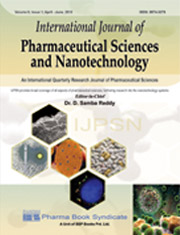Surface Solid Dispersion – A Review
DOI:
https://doi.org/10.37285/ijpsn.2013.6.1.1Abstract
Preparation of an effective formulation of poorly water-soluble drugs is a key challenge in pharmaceutical technology. Dissolution rate and solubility are the rate- limiting steps for increasing the bioavailability of poorly water‐soluble drugs. Solid dispersion is an efficient technique for improving dissolution rate and subsequently, the bioavailability of poorly water‐soluble drugs. Surface sSolid dDispersion is a novel technique of solid dispersion for dispersing one or more active ingredients on a water insoluble carrier of high surface area in order to achieve increased dissolution rates and bioavailability of insoluble drugs. The Vvarious polymers used in this technique are Avicel, Crosspovidone, sSodium starch glycolate, pPregelatinized starch, Cab-o-sil, Ac-di-sol, KyronT-314, Primojel and pPotato sStarch. This article reviews the various methods of preparation and characterization of surface solid dispersion and compiles some of the drugs formulated as surface solid dispersions. Some of the practical aspects to be considered for preparing surface solid dispersion are selection of a suitable carrier and method of preparation of surface solid dispersion.
Downloads
Metrics
Keywords:
Bioavailabilty, Dissolution rate, Carrier, Solid Dispersion, WettabilityDownloads
Published
How to Cite
Issue
Section
References
Babu PS and Chowdary KPR (2008). Enhancement of dissolution rate of celecoxib by solid dispersion in superdisintegrants. Indian Drugs 45: 547-552.
Bhise SB and Rajkumar M (2008). Effect of HPMC on solubility and dissolution of carbamazepine Form III in simulated gastrointestinal fluids. AJP 2: 38-42.
Cassidy OE and Rouchotas C (2000). Comparison of surface modification and solid dispersion techniques for drug dissolution. IJP 195: 1–6.
Chatham SM (1987). The use of bases in SSM formulations. S. T.P. Pharma.3: 575-582.
Charumanee S, Okonoki S and Sirithunyalug J (2004). Improvement of dissolution rate of piroxicam by surface solid dispersions.CMU Journal 3: 77-84.
Chaulang G, Patil K, Ghodke D, Khan S and Yeole P (2008).Preparation and characterization of solid dispersion tablet of furosemide with crospovidone. Research J Pharm and Tech 1(4):386-389.
Chowdary KPR and Srinivasa Rao SK(2000). Investigation of dissolution enhancement of itraconazole by solid dispersions in superdisintegrants. DDIP 26: 1207-1211.
Corrigan OE (1985). Mechanism of dissolution of fast release soliddispersions. Drug Dev. Ind. Pharm.11: 697-724.
Dhirendra K, Lewis S, Udupa N and Atin K (2009). Solid dispersion,an overview. Pak J Pharm Sci 22: 234-246
Dixit RP and Nagarsenker MS (2007). In vitro and in vivo advantage of celecoxib Surface solid dispersion and dosage Form development. IJPS 69: 370-377.
Docoslis A, Huszarik KL, Papageorgiox GZ, Bikiaris D, Stergion A and Georgarakis E (2007). Characterization of the distribution,polymorphism and stability of nimodipine in its Solid dispersions in polyethylene glycol by micro-Raman Spectroscopy and Powder X-Ray diffraction. AAPS Journal 9: 361-370.
Duncan QMC (2002). The mechanism of drug release from solid dispersion in water soluble polymers. Int J Pharm 231: 131-144.
Francois D and Jones BE (1978). The hard capsule with the soft center. European Capsule Technology Symposium. 55-61.
Giri TK, Jana P and Sa B (2008). Rapidly Disintegrating Fast release tablets of diazepam using solid dispersion: Development and evaluation. J Sci Ind Res 67: 436-439.
Goldberg AH, Gibaldi M, Kanig JL and Mayersohn M (1996). Increasing dissolution rates and gastrointestinal absorption of drugs via solid dispersion in eutectic mixtures IV.Chloramphenicol-urea system. J. Pharm. Sci.55: 581-583.
Gupta MK, Goldman D, Bogner RH and Tseng YC (2001).Enhanced drug dissolution and bulk properties of solid dispersions granulated with a surface adsorbent. Pharm Dev Tech 6: 563-
Leuner C and Jennifer D (2000). Improving drug solubility for oral delivery using solid dispersions. Eur J Pharm Biopharm 50: 47-60.
Liu R (2007).Water insoluble drug formulation.Library of Congress Cataloging-in-Publication Data.
Moneghini M, Kikic I, Voinovich D, Perissutti B and Grcic JF (2001). Processing of carbamazepine-polyethylene glycol 4000 solid dispersions with supercritical carbon dioxide: preparation,characterization and in vitro dissolution. IJP 222: 129-138.
Naga Aparna.T (2011).Studies on enhancement of dissolution rate of Domperidone by surface solid dispersion technology. IJRPC 1(2):133-134.
Nokhodchi A, Talari R, Valizadeh H, and Jalali MB (2007). An Investigation on the solid dispersions of chlordiazepoxide. IJBS 3(3): 210-216.
Okonogi S and Puttipipatkhachorn S (2006). Dissolution improvement of high drug-loaded solid dispersion. AAPS PharmSciTech 7: 148-153.
Pinnamaneni NG, Das NG and Das SK (2002). Formulation approaches for orally administered poorly soluble drugs. Pharmazie 57: 291–300.
Raymond CR, Sheskey PJ and Marian ME (2009). Handbook of Pharmaceutical Excipients, 6th ed. 132-731
Renu K and Patel P (2010). Solid dispersion: A method for enhancing drug dissolution. IJDFR 1: 1-14.
Serajuddin ATM (1999). Solid dispersion of poorly water soluble drugs, early promises, subsequent problems and recent breakthroughs. J Pharm Sci 88: 1058-1066.
Serajuddin ATM, Sheen PC, Mufson D, Bernstein DF and Augustine MA(1988). Effect of vehicle amphiphilicity on the dissolution and bioavailability of a poorly water-soluble drug from solid dispersions. J. Pharm. Sci. 77: 414-417.
Vadnere MK, James Swarbrick and James C Boylan Eds (2002). Coprecipitates and melts. Encylopedia of Pharmaceutical technology 1: 642-644
Vanshiv SD, Rao MRP, Sonar GS, Gogad VK and Borate SG (2009). Physicochemical characterization and in vitro dissolution of domperidone by solid dispersion Technique. IJPER 43: 86-90.
Williams AC, Timins P, Lu M and Forbes RT (2005). Disorder and dissolution enhancement: deposition of ibuprofen onto insoluble polymers. EJPS 26: 288-294.
Yadav BV and Yadav VA (2010). Enhancement of solubility and dissolution rate of BCS Class 2 pharmaceuticals by nonaqueous granulation technique. IJPR 1: 1-12.






